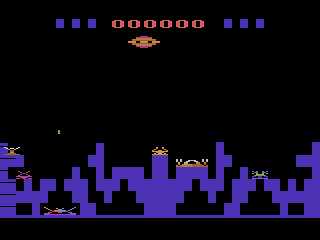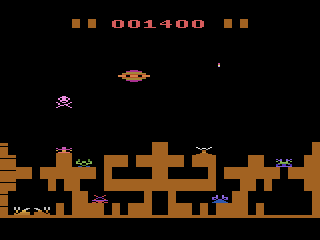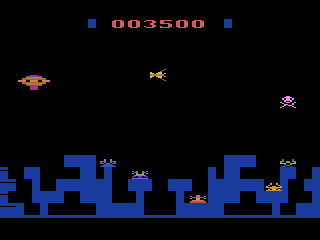Retro Replay Review
Gameplay
Z-Tack places you in command of a sleek, hovering saucer with one mission: obliterate the cities sprawled beneath you while evading relentless counterattacks. Movement is completely freeform—you can dart in any direction with the joystick—while firing is handled by holding the fire button and pushing in the desired direction. This intuitive twin-stick–style setup rarely feels restrictive, and it allows for dynamic strafing runs and rapid retreats when the ground-based defenses get too intense.
(HEY YOU!! We hope you enjoy! We try not to run ads. So basically, this is a very expensive hobby running this site. Please consider joining us for updates, forums, and more. Network w/ us to make some cash or friends while retro gaming, and you can win some free retro games for posting. Okay, carry on 👍)
The core challenge comes from the evolving threat of enemy projectiles. In the opening levels, simple missiles streak upward, forcing you to weave around them and time your shots carefully. As you progress, those missiles morph into delicate balloon bombs that drift ominously. While harmless if shot, you’ll quickly learn that a suicidal collision can be just as deadly as any guided missile. Later on, the game ups the ante by introducing horizontally traveling bombs that suddenly break formation the moment you align vertically with them—driving home the lesson that staying unpredictable is key.
Z-Tack offers four distinct game variations: beginner and advanced modes for one or two players. The beginner settings give you a more forgiving missile pattern and slower balloon speeds, while the advanced modes throw tighter, faster volleys at you from the very first level. Two-player alternation keeps the competition friendly but fierce, as each pilot vies to outscore the other before handing off the controls. The progression is straightforward—destroy every city on screen to advance—yet reaching that final target of 999,999 points before your saucer fleet is grounded adds a strong incentive to keep pushing.
Graphics
Graphically, Z-Tack is a testament to the charm of early-’80s arcade design. The cityscapes are rendered in crisp, blocky pixels that convey a surprising amount of detail given the hardware limitations of the era. Each metropolis you encounter has its own color scheme—ranging from fiery oranges to cool blues—so you always know which level you’re tackling at a glance.
The saucer itself is a standout, boasting smooth rotation animations and a distinctive glowing center that pulses with each shot. Enemy missiles are rendered as thin, jagged lines, while the balloon bombs are rendered as round sprites with subtle shading that gives them a three-dimensional feel. When a city is destroyed, an explosion sequence of expanding pixels and flashing lights makes the devastation visually satisfying without feeling gratuitous.
Despite the simple color palette, Z-Tack maintains excellent clarity even when the screen fills with crossfire. You rarely lose track of your saucer among the chaos, and the framerate remains stable throughout. Occasional screen flicker adds a nostalgic authenticity rather than detracting from playability—conjuring the flickering neon glow of an arcade cabinet’s CRT.
Story
At its heart, Z-Tack offers a minimalist but engaging sci-fi premise: you are an invading saucer on a mission of airborne supremacy, systematically erasing humanity’s urban footprints. There’s no dialogue or elaborate backstory, but the act of leveling city after city creates an unmistakable narrative of unstoppable alien might. It’s a pure arcade fantasy grounded in the simple goal of survival and destruction.
While the story doesn’t evolve through textual exposition or cutscenes, the sense of progression comes through in the increasing sophistication of the defense systems. You quickly piece together an unspoken tale: humanity adapts to your tactics, deploying new weaponry (balloon bombs, horizontal missiles) in hopes of repelling your invasion. This silent escalation provides all the narrative tension you need.
The four game modes subtly alter the implied stakes. In beginner levels, you almost feel like a testing pilot before your superiors, learning the ropes of interplanetary warfare. In advanced two-player mode, the war intensifies, and the vacant cityscapes you leave behind feel all the more foreboding as you compete for supremacy. Though light on exposition, Z-Tack’s atmosphere is amplified by your own imagination.
Overall Experience
Playing Z-Tack is like stepping back into a golden age of arcade shooters—each run feels immediate, challenging, and endlessly replayable. The learning curve is gentle enough for newcomers to get a handle on the controls, yet deep enough that veteran players can master advanced strategies, like baiting horizontal bombs or chaining city destructions in tight succession. The alternating two-player modes add a social component, fostering friendly rivalries in cramped living rooms or late-night arcade dens.
While modern gamers might notice the absence of a sprawling narrative or hyper-realistic visuals, Z-Tack shines through its pure, distilled gameplay loop. There’s a satisfying rhythm to the attack-dodge-retreat cycle, and the visual feedback—city explosions, missile trails, and saucer animations—keeps you hooked. Every new level presents a fresh opportunity to refine your approach and chase that elusive high score.
For anyone seeking a classic shoot-‘em-up experience with straightforward mechanics and escalating challenge, Z-Tack remains a must-play. Its blend of freeform movement, varied enemy patterns, and nostalgic charm ensures that each session is as engaging as the last. Whether you’re a seasoned arcade aficionado or a curious newcomer, Z-Tack delivers an addictive dose of saucer-based destruction that stands the test of time.
 Retro Replay Retro Replay gaming reviews, news, emulation, geek stuff and more!
Retro Replay Retro Replay gaming reviews, news, emulation, geek stuff and more!








Reviews
There are no reviews yet.